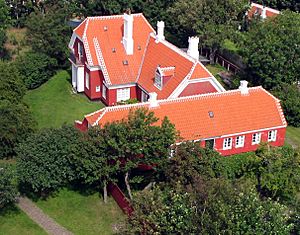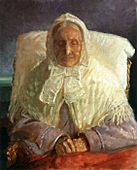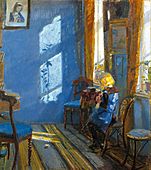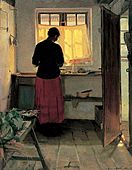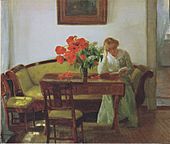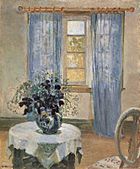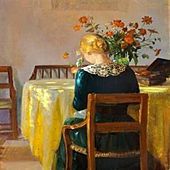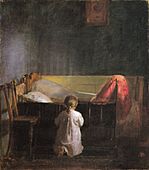Anna Ancher facts for kids
Quick facts for kids
Anna Ancher
|
|
|---|---|
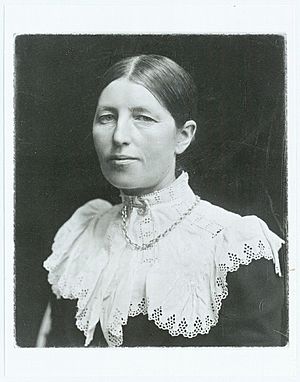
Photo by Frederik Riise
|
|
| Born |
Anna Kirstine Brøndum
18 August 1859 Skagen, Denmark
|
| Died | 15 April 1935 (aged 75) Skagen, Denmark
|
| Nationality | Danish |
| Education | Vilhelm Kyhn College of Painting Pierre Puvis de Chavannes |
| Known for | Painting |
|
Notable work
|
Sunlight in the Blue Room |
| Movement | Impressionist |
| Awards | Ingenio et Arti Tagea Brandt Rejselegat |
Anna Ancher (18 August 1859 – 15 April 1935) was a Danish artist associated with the Skagen Painters, an artist colony on the northern point of Jylland, Denmark. She is considered to be one of Denmark's greatest visual artists.
Contents
Background
Anna Kirstine Brøndum was born in Skagen, Denmark, the daughter of Ane Hedvig Møller (1826–1916) and Erik Andersen Brøndum (1820–1890). She was the only one of the Skagen Painters who was born and grew up in Skagen, where her father owned the Brøndums Hotel. The artistic talent of Anna Ancher became obvious at an early age and she became acquainted with pictorial art via the many artists who settled to paint in Skagen, in the north of Jylland.
While she studied drawing for three years at the Vilhelm Kyhn College of Painting in Copenhagen, she developed her own style and was a pioneer in observing the interplay of different colors in natural light. She also studied drawing in Paris at the atelier of Pierre Puvis de Chavannes along with Marie Triepcke, who would marry Peder Severin Krøyer, another Skagen painter.
In 1880 she married fellow painter Michael Ancher, whom she met in Skagen. They had one child, daughter Helga Ancher. Despite pressure from society that married women should devote themselves to household duties, she continued painting after marriage.
Career
Anna Ancher was considered to be one of the great Danish pictorial artists by virtue of her abilities as a character painter and colorist. Her art found its expression in Nordic art's modern breakthrough toward a more truthful depiction of reality, e.g. in Blue Ane (1882) and The Girl in the Kitchen (1883–1886).
Style
Ancher preferred to paint interiors and simple themes from the everyday lives of the Skagen people, especially fishermen, women, and children. She was intensely preoccupied with exploring light and color, as in Interior with Clematis (1913). She also created more complex compositions such as A Funeral (1891). Anna Ancher's works often represented Danish art abroad. Ancher has been known for portraying similar civilians from the Skagen art colony in her works, including an old blind woman.
..... The religious context of the painting could be related to Ancher's own religious upbringing. ..... Scholar Alice R. Price asserts that this painting is a reflection of Ancher's position as a woman of faith living in the traditional bohemian lifestyle of artists, that Price interprets as indicative of an ongoing inner conflict for the artist.
Recognition
She exhibited her work at the Palace of Fine Arts at the 1893 World's Columbian Exposition in Chicago, Illinois. She was awarded the Ingenio et Arti medal in 1913, and the Tagea Brandt Rejselegat in 1924.
Ancher was included in the 2018 exhibit, Women in Paris 1850-1900.
Residence
The Skagen residence of Anne and Michael Ancher was purchased in 1884. In 1913, a large studio annex was added to the property. This also formed part of what is on display publicly today as a museum dedicated to both Anna and Michael Ancher. Upon her death in 1964, their daughter, Helga Ancher, left the house and all of its contents to a foundation. The former residence was restored and opened as a museum and visitor attraction.
In 1967, Michael and Anna Ancher's house (Anchers Hus) in Skagen was converted into a museum by the Helga Ancher Foundation before Anchers Hus opened to the public for tours. The original furniture and paintings created by the Anchers and other Skagen artists are shown in the restored home and studio. Art exhibitions are arranged in the Saxild House (Saxilds Gaard), another building on the property. It is filled with displays of paintings by Michael and Anna Ancher, as well as by many other Skagen painters who made up their circle of friends.
Danish thousand-kroner banknote
Anna and Michael Ancher were featured on the front side of the DKK1000 banknote, which came into circulation on 25 November 2004 and subsequently, was replaced. The front of the banknote had a double portrait of Anna and Michael Ancher, derived from two 1884 paintings by Peder Severin Krøyer, which originally hung on the walls in the dining room at Brøndums Hotel.
Paintings
Retrospective exhibitions
- Anna Ancher – Skagens indre og ytre rom, Lillehammer Kunstmuseum, Norway, 2021
- I Am Anna. A Homage to Anna Ancher, Skagens Museum, Denmark, 2009
- Anna Ancher, Arken Museum of Modern Art, Copenhagen, 2011
- Anna Ancher & Co.—The Painting Women, Ribe Kunstmuseum, Denmark, 2007
- Anna Ancher—det besjælede rum, Ribe Kunstmuseum, Denmark, 1999
- Anna Ancher, 1859–1935, Malerin in Skagen, Niedersächsisches Landesmuseum, Hannover, 1994–1995
See also
 In Spanish: Anna Ancher para niños
In Spanish: Anna Ancher para niños
- Skagen Painters
$



